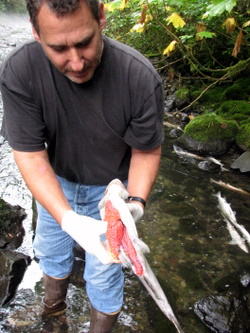
The Indian River near Sitka boils with pink salmon as a pair of National Park Service biologists walk upstream. There may be over 300,000 fish in the system, 3-4 times the optimum amount. (KCAW photo/Robert Woolsey)
Some rainfall over the weekend may have eased a looming crisis for pink salmon stocks in Southeast Alaska. The summer’s fine weather and record salmon runs have both made headlines – but they’re a recipe for trouble without enough water in rivers and streams for fish to spawn.
KCAW’s Robert Woolsey visited Sitka’s Indian River to learn how the salmon were doing.
Listen to iFriendly audio.

ADF&G biologist Dave Gordon examines a dead female pink salmon. The egg skein is intact. This fish — and many others — did not spawn. (KCAW photo/Robert Woolsey)
The Indian River is a mid-sized system. It drains a large valley to the east of Sitka, but there are no glaciers or permanent snowpack feeding it.
I’m standing in the river bed – wearing running shoes. It didn’t even occur to me to wear boots. The Indian River is low, and there are more fish in it than I’ve ever seen.
We spook two or three hundred pink salmon, and they surge away across the shallow gravels, leaving us standing among carcasses.
I’m with Dave Gordon, the area management biologist for Fish & Game, and his tech, Jess Coltharp. A stream plugged with salmon is a good thing, but there is a problem. Gordon picks up a pink salmon and cuts it open.
“It’s been dead a long time… There’s another one: still in the skein. Obviously didn’t die from spawning. It died from stress of some kind. So based on that sample, I’d say a high percentage of the mortality you’re seeing here are unspawned fish.”
Gordon cuts open five dead females and all still have eggs. But he is not necessarily alarmed. For these salmon to have survived two years in the ocean, and then come this far upstream only to die on the banks is not that unusual.
“I think you always have a certain amount of stress mortality associated with the spawning event. So you’re going to see pre-spawned fish die even when the water is in better shape than it is here. The water quality in this case is definitely adding to the stress a lot, and it’s probably causing a higher number to die before they spawn.”
Decaying fish rob the stream of oxygen. In a normal year, carcasses are flushed out to sea. Obviously, low rainfall is at the heart of the problem here – but are there also just too many fish?
“This is an all-time record for Alaska. Right now something above 250 million fish have returned,” says Steve Reifenstuhl, the general manager of the Northern Southeast Regional Aquaculture Association. In this job, and in his previous position with a local processor, he’s worked closely with the seine fleet, who’s bread-and-butter is pink salmon. In Southeast, fishermen have taken nearly 90-million pinks.
“We probably left 10-million – maybe 20-million pink salmon in the ocean – that weren’t needed for escapement that could have been harvested, if there would have been sufficient process capacity.”
But catching those fish, Reifenstuhl says, would have been unrealistic. The industry in Southeast can best handle about 70-million fish.
“You know, you can’t build infrastructure for a once-in-a-120 year event.”
“Less fish would have been a good thing at this stage,” says Dave Gordon, “But there’s a lot of systems that are much smaller than this, much smaller watersheds, much more dependent on the rainfall to have any water at all. Those are getting desperately low.”
Gordon thinks there are probably about three times as many fish in Sitka’s Indian River than it can accommodate, and more are holding off the mouth in saltwater, waiting for the stream to rise. But they can’t hold forever. Enough will make it, though, to maintain the stocks. Gordon thinks the system would be at risk of a crash only if dry weather persisted well into September.
That’s not a big worry at the moment. Gordon, like any fisheries manager, is worried about taking my call next year.
“I think what happens when people see this – and next year we’re going to get something more normal – they’re going to go, Where’s all the fish?”































